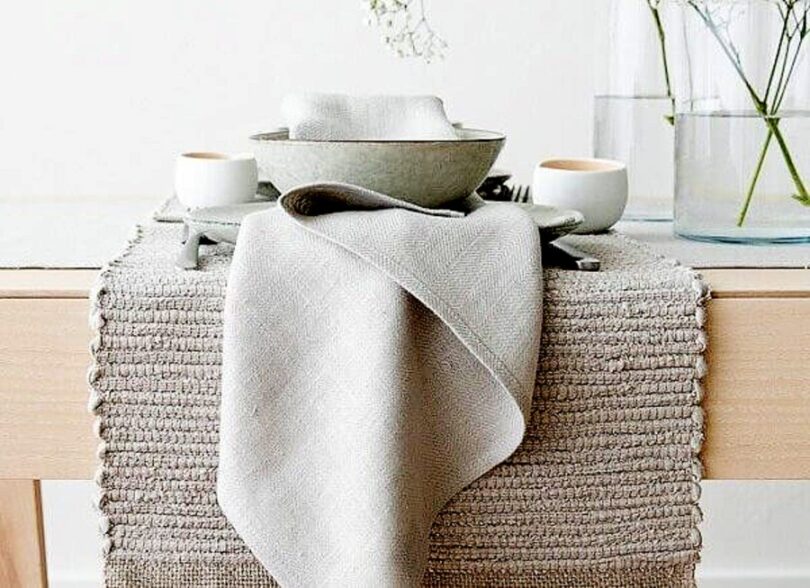Linen fabric is famous for its versatility, natural beauty, and comfort it offers. But what you may not know is there are many types of linen. These linen variations have different qualities, and it’s crucial to understand them for you to choose the ideal one for making your items.
Linen is sourced from the stem of the flax plant. Considering its strength, durability, and antibacterial properties, it remains an important fabric in the cloth manufacturing industry. It’s also ideal for home décor, and the different types of this material give it a personalized feel. As you can see, many properties of linen fabric are very beneficial, therefore it’s no surprise that linen becomes very popular.
Properties of Linen
Linen is a cool fabric ideal for summer, but it also works well during winter. It is lustrous and stronger than cotton, and it gets softer after each subsequent washing. It is also resistant to dirt and moths, but it doesn’t stretch. Therefore, if you crease or fold them repeatedly during storage, their threads will start to break after some time.
Additionally, linen also wrinkles easily due to its lower elasticity. You will also find it in different colors, including tan, ivory, grey, and ecru. It’s also easier to dye it to different colors and is available in various thicknesses and grades.
Types of Linen Fabric
-
Loosely Woven Fabrics
These fabrics are made to be highly absorbent and very smooth. Loosely woven fabrics are common in sanitary towels and diapers. One popular variety is Bird’s eye linen which has geometric patterns similar to the eyes of birds. Huckaback linen fabric is another good example; it’s made from pure linen or a combination of cotton and linen. Since the fabric is woven in towel lengths, it is absorbent and also lightweight.
-
Linen Fabric
This fabric is made on a jacquard loom using satin and plain weaves. It has a smooth texture and reversible pattern due to the flat nature. It is also available in one color making its pattern and design outstanding. This fabric is usually used in manufacturing linen tablecloths, napkins, home, and more.
-
Plain-woven Linen Fabric
This fabric is commonly used in making wiping glassware. The plain-woven fabric has a striped or checkered pattern of blue, red, or both. Considering its loose wave, it’s highly absorbent, making it ideal for cleaning. However, it’s less durable, and it has a variation called Holland linen, treated with starch and oil to make it opaque. Therefore, the sun’s rays do not penetrate this material, making it famous for manufacturing lampshades and window shades.
-
Sheeting Linen
This linen is a heavy fabric from its name, and it’s wider for making linen sheets. It is also used to make linen dresses, linen suits, and other clothing.
- Cambric Linen – The name “cambric” is derived from the first source of this material: Cambria in France. It is the thinnest and most delicate linen fabric and is plain-woven due to its properties. It’s used to make lingerie, handkerchiefs, and other delicate garments. One example is the Butcher’s linen; this is a stiff and coarse material used for manufacturing heavy-duty linen clothes like aprons.
- Toweling – This is the last linen fabric on our review. From its name, it’s used to make towels and is available in different sizes. Some are also versatile and can be used for different purposes.
European and Other Countries’ Linen
The major difference that arises in linen is where it is sourced. For instance, you may already be familiar with Belgian linen since it’s of the highest quality. The French linen is also equally popular, and the European linen is sourced from these countries hence their high quality.
The coastal areas in Belgium and northern France have massive flax fields. These areas have cool climates that promote the growth of flax. Belgium, France, and the Netherlands are the biggest sources of flax which is extracted from the stem. Additionally, you will find flax in other countries like China, the US, Ireland, and Italy, but they’re not used more in other products such as flaxseed oil.
How It Differs From Other Fabrics
- Cotton – Cotton is a staple fiber extracted from the cotton plant. It is soft and fluffy material that can create a soft fabric. Linen is more durable than cotton, but it’s less flexible and does not stretch like cotton. Though some cotton varieties are finer, they cannot match the durability of linen. Linen is longer and tightly packed. cellulose fibers which make it more rigid
- Canvas – This fabric is typically manufactured from the heavy cotton yard and little linen yarn. It is famous for its durability, sturdiness, and heavy-duty nature. It can be blended with other synthetic fibers like cotton to make it waterproof or water-resistant. It’s commonly used in making camping tents, umbrellas, and rain-resistant coats.
- Chenille – This is a soft material that is popular in the market. This name refers to the fabric and yard used to manufacture it. In Chenille, the threads are piled carefully to create the yarn, similar to the caterpillar’s exterior. And since it is woven, it can be made from different fibers such as silk, cotton, rayon, and wool.
- Cashmere – From its name, this wool fabric is manufactured from the wool of pashmina and cashmere goats. Cashmere is a natural fiber and is popular for its excellent insulation and soft feel. It also has fine fibers and is silky when touched. However, it’s quite warmer than the sheep‘s wool and is also lightweight since it’s usually combined with other types of yarn. This is because it has a lighter weight and blending with other types of wool increases its weight.
Bottom Line
If you are looking for the best linen for your needs, you will need to understand the different fabrics’ feel and characteristics. Linen is also the world’s strongest fiber and is more durable than cotton. Its strength also translates to stronger garments, and linen clothing will last you for some seasons.
Additionally, linen is also hollow to ensure more airflow in your body. It’s better than most fabrics in the market, and since it’s also highly absorbent and hypoallergenic, it’s suitable for even baby clothing. Finally, since you have different linen, sizes, and designs, it is easier to choose your ideal fabric without compromising comfort.








